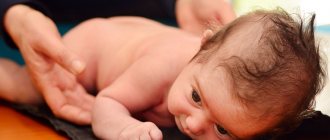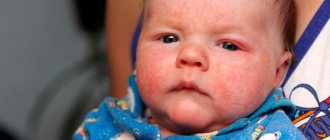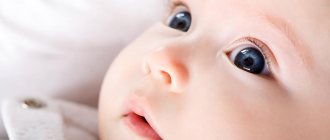Bacterial conjunctivitis of the eyes in a child
The cause of this type of disease is the contact of various pathogens on the mucous membrane of the organs of vision: gonococci, staphylococci, streptococci and other pathogenic microorganisms. This can happen when the baby bathes in insufficiently clean water or when rubbing the eyes
In this article
- Bacterial conjunctivitis of the eyes in a child
- Dacryocystitis of the eye in newborns
- Requirements for eye massage in newborns
- How to do eye massage for newborns correctly
- What to do if massage does not help with conjunctivitis and dacryocystitis
- Hygiene during treatment of dacryocystitis and conjunctivitis in children
with dirty hands, and there are also frequent cases of infection of the child at the time of birth if pathogens are present in the mother’s genitourinary area. In medical practice, there is a special term - ophthalmia of newborns. This is the name for inflammatory diseases of the visual organs after birth. At the same time, one should not confuse the regular accumulation of exudate in the inner corner of the baby’s eye, as often happens in the morning, with conjunctivitis of the eyes, the signs of which are quite pronounced: copious discharge of pus, increased lacrimation, itching, sticking of eyelashes in the morning, restless behavior of the child. Often, pathology develops in both eyes at once.
Complications and consequences
Dacryocystitis is not considered a dangerous disease for very young children and can be successfully treated. However, if therapeutic measures are not taken on time, various kinds of unpleasant complications may develop, such as:
- Extensive inflammatory process in the tissues of the eyelids.
- Accumulation of purulent contents in the cavity of the lacrimal sac, its infection.
- Cystic formations in the lacrimal sac. This problem can also be noticed visually: a clearly visible compaction of various sizes appears in this area of the eye.
- A purulent inflammatory process affecting the entire eye area, which ultimately can lead to permanent loss of vision.
- Blood poisoning.
- Inflammation of the brain.
If the disease itself does not pose a particular danger to the health and life of the baby, then its consequences that arise from improper treatment or its absence can be very serious, negatively affecting the general condition of the baby’s body, and can lead to disability and death.
Dacryocystitis of the eye in newborns
Another common eye pathology in infancy is dacryocystitis. This is an obstruction of the lacrimal canal, which causes stagnation of tears in it. There are two such tubules in total - on the side of the upper eyelid and the lower. 90% of the tear fluid flows through the lower canal into the nose, further moisturizing it from the inside. This is why when we cry and excessive lacrimation occurs, a runny nose occurs. Before a baby is born, its tear ducts have a thin membrane of fetal tissue. It protects the visual organs from amniotic fluid entering them. Usually this film breaks after birth, when the baby takes his first breath and his eyes begin to work normally. However, it happens that the film does not want to break, and then the normal outflow of tears is disrupted, infection occurs and dacryocystitis occurs - purulent inflammation of the lacrimal sac. Here are the main manifestations of this disease in a newborn:
- purulent discharge from the baby’s eyes in the second week of life;
- redness of the conjunctiva and skin at the inner corner of the eye;
- painful swelling, swelling of the eyelids;
- lacrimation;
- discharge of pus when pressing on the area of the lacrimal sac;
- eyelashes stuck together after sleep;
- temporary effect from the use of antibiotics and antiseptics.
Externally, the manifestations of the disease resemble eye conjunctivitis, and parents often practice independent treatment: washing the eyes with chamomile or tea infusion, instilling antibacterial drops. The symptoms disappear for a while and then recur. Since the main cause is not eliminated, the tear continues to stagnate, new bacteria enter the palpebral fissure and begin to multiply.
Every time a child develops purulent discharge from the eyes, there is no need to look for advice on the Internet; it is worth visiting an ophthalmologist for diagnosis. Only a specialist will determine what pathology caused the inflammation: conjunctivitis, dacryocystitis or something else. Standard treatment regimens for inflammatory eye diseases include rinsing the vision organs, administering drops and ointments. The doctor may also additionally prescribe an eye massage for clogged tear ducts to more effectively remove excess pus. It can be carried out by parents independently at home. Massage is an important procedure at the initial stage of treatment of eye conjunctivitis and dacryocystitis, as it affects the cause and is aimed at improving the patency of the lacrimal ducts.
Causes of poor lacrimal duct obstruction in infants
Under normal conditions, during blinking, the eyeball is moistened with tear fluid. This phenomenon prevents the eyeball from drying out and maintains normal vision. The tear collects in the lacrimal sac. It leaves the body through the nasolacrimal ducts.
If this channel is obstructed, the outflow of tear fluid is difficult or does not occur at all. A disease occurs - dacryocystitis (inflammatory disease of the lacrimal sac). Parents may not be aware of the presence of such a structural feature of the baby’s organ of vision and even give him antibiotics on their own. This cannot be done, because blockage of the tear duct is a genetically determined disease.
If the blockage of this part of the organ of vision is not treated, the newborn will develop chronic conjunctivitis. The pathology in some cases leads to loss of vision.
Obstruction of the lacrimal canal develops from the fact that during the prenatal period it is covered with a membrane. Because of this, amniotic fluid does not enter the canal. By the time of birth, the membrane dissolves with the first breath. This ensures the physiological outflow of tear fluid. But in some infants the membrane remains, causing obstruction of the lacrimal canal - dacryocystitis.
This disease also develops with obstruction of the lacrimal canal due to its true fusion. Often the outflow of tears becomes impossible due to infection.
Requirements for eye massage in newborns
Massaging with conjunctivitis or dacryocystitis requires compliance with certain rules so as not to harm the newborn. Be sure to cut long nails - they can injure the child's delicate skin or eyes. Wash and dry your hands thoroughly to avoid introducing another infection. You need to massage when the baby is in a calm, relaxed state, preferably five minutes after feeding. Do not carry out this procedure if the baby feels unwell or has a fever. Before you start massaging your eyes, rinse them and clean them of any traces of purulent discharge.
Take an antiseptic liquid - it can be a weak solution of furatsilin, a decoction of chamomile, or a weak infusion of tea. A cotton swab is moistened in the liquid and the pus is carefully removed, making movements from the outer edge of the eye to the inner, that is, from the temple to the nose. Use a separate cotton pad for each eye.
Preparing and performing massage
You are convinced that your child really has dacryocystitis and the membrane is preventing the passage of tear fluid through the canals. It is necessary to start preparing for the massage. It should include the following actions:
- Make sure that your nails do not harm the child.
- Wash your hands clean.
- Test your baby for an allergic reaction to the cream that you will subsequently use for massage.
- Rinse the child's eye with disinfectant solutions, for example, furatsilin or chamomile, or even with ordinary boiled water. The mixture should be slightly warmed. Rinse the eye, freeing it from mucus, moving a cotton swab from the outer side of the corner to the inner one, first moisten it in the prepared solution.
- Warm up your hands to a comfortable state for the child.
- Prepare your own swab for each eye.
- Lubricate the finger with which you will massage with warm cream.
If there is no thick composition, the washing procedure can be replaced by instillation. To do this, turn the child on his side and drop a wash or disinfectant onto the outer corner area. The mixture will wash the mucous membrane, flowing to the inside of the eye.
Massage technique
It is advisable to watch the video before performing it.
And then we proceed to the following procedures:
- Let's prepare a hard surface and lay the baby on it.
- Use the pad of your finger to find the location of the lacrimal sac.
- Sliding easily, but with a certain degree of pressure, we move from this point to the wing of the nose.
- This massage must be repeated 5 to 10 times, depending on the recommendation of the ophthalmologist.
- After finishing the massage, we instill the eye drops prescribed by the doctor.
We use a changing table or simply an elastic mattress as a hard surface. In the future, you will develop the necessary skills, and you will be able to perform the massage process during feeding. There is no need to fix the child's head.
Due to this procedure, we will create pressure on the nasolacrimal duct. The embryonic tissue of the membrane will become thinner and rupture will occur. You need to perform massage movements at a fast pace according to the pattern shown in the picture. Its duration should be no more than two seconds.
Instillation is done to prevent the infection from spreading further and harming the healthy eye.
| Massage of the lacrimal canal in newborns must be repeated methodically from 5 to 10 times a day. Sometimes it is carried out for two weeks in a row, until the integrity of the membrane is broken and the secretion accumulated in the lacrimal sac appears from the nostrils. |
It may be clear or purulent if there is a bacterial infection. Then the child must be shown to a doctor, who will determine whether the tear duct has opened. And he will either offer to continue the massage or prescribe a probing procedure, which is usually performed once. It will restore the patency of the lacrimal canal.
How to do eye massage for newborns correctly
The doctor will show you how to properly massage the lacrimal sac so that the process brings maximum benefit. You can also feel this pouch in yourself to better understand where it is. Place your index finger on the point in the inner corner of the eye where two canaliculi meet before entering the lacrimal sac. The pressure should not be too strong, but at the same time sufficient to expel the pus. From the found point, move from top to bottom towards the child’s nose, lightly pressing your finger. It is necessary to make approximately 6-10 such movements. In this case, pus should be released from the lacrimal sac - this is an indicator that the eye massage is carried out correctly. It is removed with a cotton swab and this continues until the contents of the canal stop coming out.
After completing the procedure, you need to rinse the eye with antiseptic solutions and then instill an antibiotic. This could be a solution of Levomycetin 0.25%, Vitabact or other means. Experts recommend performing eye massage for conjunctivitis in children or obstruction of the lacrimal duct for two weeks, while using antibacterial drops or ointments. Usually during this time the process normalizes and the tear begins to flow normally.
As a rule, the doctor’s prescription looks like this:
- eye massage - 4 times a day for 6-10 movements;
- washing with an antiseptic solution;
- "Levomycetin" 0.25% 1 drop * 4-5 times a day.
How to properly massage the tear duct for adults
Most often in adults, dacryocystitis is a complication of eye diseases and pathologies of the lacrimal canal. At first, the disease is hidden, there are no visible symptoms, there is no discomfort or pain. The manifestation begins with a small swelling at the bottom of the eye, a feeling of fullness at the location of the lacrimal sac. There may be redness of the skin and cloudy discharge from the eye.
As soon as you notice the first, minor symptoms of the disease, you should immediately start massaging the lacrimal canal.
The first rule is warm and clean hands. If you do the manipulation yourself, then watch the length of your nails so as not to injure the skin. Drop disinfectant into your eyes and wipe with cooled chamomile infusion. Subscribe to our Facebook page!
Using light circular movements, massage the area between the eye and nose, moving downwards. Then work along the entire nose. At the same time, adjust the pressure, the massage should be painless and pleasant. Tap the entire area around the eye with your fingertips, moving from the bridge of the nose to the eyebrows, and then to the lacrimal sac. If during the procedure pus is released from the eye, then we can safely say that the massage was successful. Even if there is no discharge, continue to do the manipulation regularly until all signs and symptoms disappear. What diseases of the body can swelling of the eyelids indicate?
What to do if massage does not help with conjunctivitis and dacryocystitis
It happens that the prescribed treatment does not help, and conjunctivitis of the child’s eyes occurs again and again. The doctor prescribes various antibiotics, but after a short-term improvement the eye becomes inflamed again. In this case, an operation is prescribed - probing. It is performed under local anesthesia. The doctor inserts a probe into the nasolacrimal canal, breaking through the embryonic film, and then rinses it. It is necessary to restore the patency of the canal by the age of six months, otherwise phlegmon may develop in the future. In addition, the thin membrane begins to thicken over time, and it becomes more difficult to break through.
After the operation, a course of eye massage and special drops are prescribed to prevent the formation of adhesions, which can lead to relapse of the disease, again blocking the tear duct. If probing does not have the expected effect, an additional extended diagnosis of the child’s visual organs is carried out: perhaps the reason lies in an anomaly in the development of the nasolacrimal canal, a curvature of the nasal septum or other factors. In some cases, a child may need dacryocystorhinostomy - a complex operation that is performed only when he reaches the age of 5-6 years.
What else is important to know
In newborns in the first months of life, instead of bones, the nasal septum consists only of cartilage.
Therefore, massage must be carried out especially carefully and carefully so as not to damage them. In this case, you need to ensure that the pus flowing from the peephole does not get into the nasal passages, the child’s ears or into a healthy eye.
It should also be taken into account that the older the child, the more painful the massage procedure and the rupture of the membrane that clogs the tear duct. Ideally, this problem should be solved before the baby reaches six months of age.
Do not be alarmed if, even after a second course of massage, the film blocking the tear duct does not rupture. The doctor will perform probing, clear the passage and clean the eye from accumulated pus, after which he will rinse it with a disinfectant solution. However, probing does not mean complete recovery. After the operation, you will need to continue performing massage and using antiseptics in order to completely stop the inflammation, remove any remaining pus and prevent relapses of the disease.
Summary: Dacryocystitis belongs to the category of simple ophthalmological pathologies in children, but nevertheless, inflammation cannot be ignored. It must be treated, otherwise the purulent infection can spread to other organs, in the most severe cases to the brain. How long it takes for dacryocystitis to go away depends on how carefully and responsibly the parents behave. With timely consultation with a doctor and consistent treatment, by 3-4 months the child’s tear ducts are restored and the inflammation completely stops.
Hygiene during treatment of dacryocystitis and conjunctivitis in children
Try not to visit too crowded places with your child - it is better to conduct the course of therapy exclusively at home. It is advisable to change the diapers in your baby's crib every day. When administering drops, make sure that the tip of the bottle dispenser does not touch the mucous membrane and skin around the eyes, otherwise this may cause re-infection. Instill exactly as much medicine as prescribed by your doctor. After completing the procedure, you need to carefully blot the area around with a clean napkin and wash your hands again.
In advanced cases, eye conjunctivitis, especially bacterial, can lead to severe damage to the eye structures and loss of vision. If treatment of dacryocystitis is delayed, phlegmon of the lacrimal sac may occur. This disease is accompanied by high fever, the child becomes restless and cries. The result of the disease can be the formation of fistulas in the lacrimal canal. Carefully following all the doctor’s recommendations, as well as observing the rules of hygiene, will help eliminate the symptoms of inflammation as soon as possible.
When is a massage prescribed?
| An important point that will lead to a positive treatment result is the time of detection of the disease. The sooner the doctor diagnoses the problem, the more successful the subsequent treatment will be. |
Late detection of the disease entails complications of varying degrees. Various adhesions and expansions may appear. The disease will enter a chronic, sluggish stage. Which will lead to regular conjunctivitis, orbital phlegmon, corneal lesions and other eye problems.
And they will require more serious treatment, sometimes even with the help of surgery. Therefore, you should carefully monitor the condition of your baby's tear ducts.
Massage is prescribed at the initial stage of a tear duct clogged with membrane, after examination by an ophthalmologist and tests. Parents can carry out this manipulation independently at home after consultation and a clear example of massage.
Clinical manifestations
Symptoms of the pathology usually appear a week after its onset. Most often, the disease is unilateral; in rare cases, manifestations of the disease are observed in both eyes at once.
The first sign of the development of dacryocystitis in newborns is considered to be lacrimation (normally, tears appear during crying in a baby only closer to 1 month of age; if the appearance of tears is noted at an earlier stage of life, this may indicate the presence of dacryocystitis).
Over time, the clinical picture becomes more extensive:
- In the area of the lacrimal sac there is slight swelling and swelling.
- When you click on this area, the transparent content is highlighted.
- A little later, the discharge becomes purulent;
The inflammatory process continues to develop, as a result of which the swelling becomes more pronounced, redness of the skin occurs, the child feels pain in the eye area, which negatively affects his condition (he often refuses to eat, becomes more restless, sleeps worse).
Is it possible to cure a port-wine stain on a newborn's face? Find out the answer right now.
Treatment using massage techniques
The first symptoms of obstruction of the tear ducts should be a reason to contact an ophthalmologist. Only a doctor has the right to prescribe treatment that will be as safe as possible for the baby and will help quickly solve the problem of dacryocystitis.
Typically, therapy involves an integrated approach and the simultaneous use of massage and medications. In more complex cases and in later stages of the disease, the child may require probing or surgery.
The main purpose of massage for dacryocystitis is to remove the film or mucus plug that blocks the outflow of tears. The additional effect of massage is to reduce purulent discharge, activate lymphatic drainage, and improve nutrition of the visual organs.
Before starting the procedure, you need to visit an ophthalmologist and, if necessary, undergo tests. If a specialist recommends a massage, then at the appointment he will demonstrate the correct technique for performing it.











